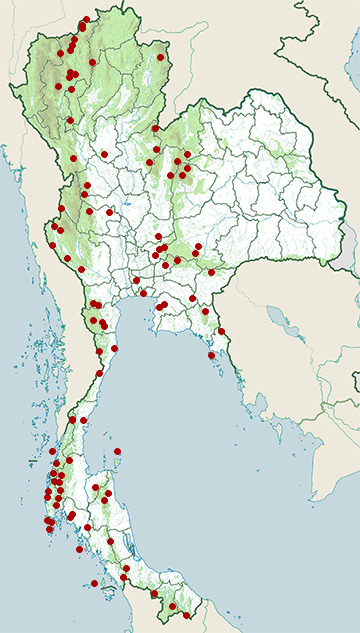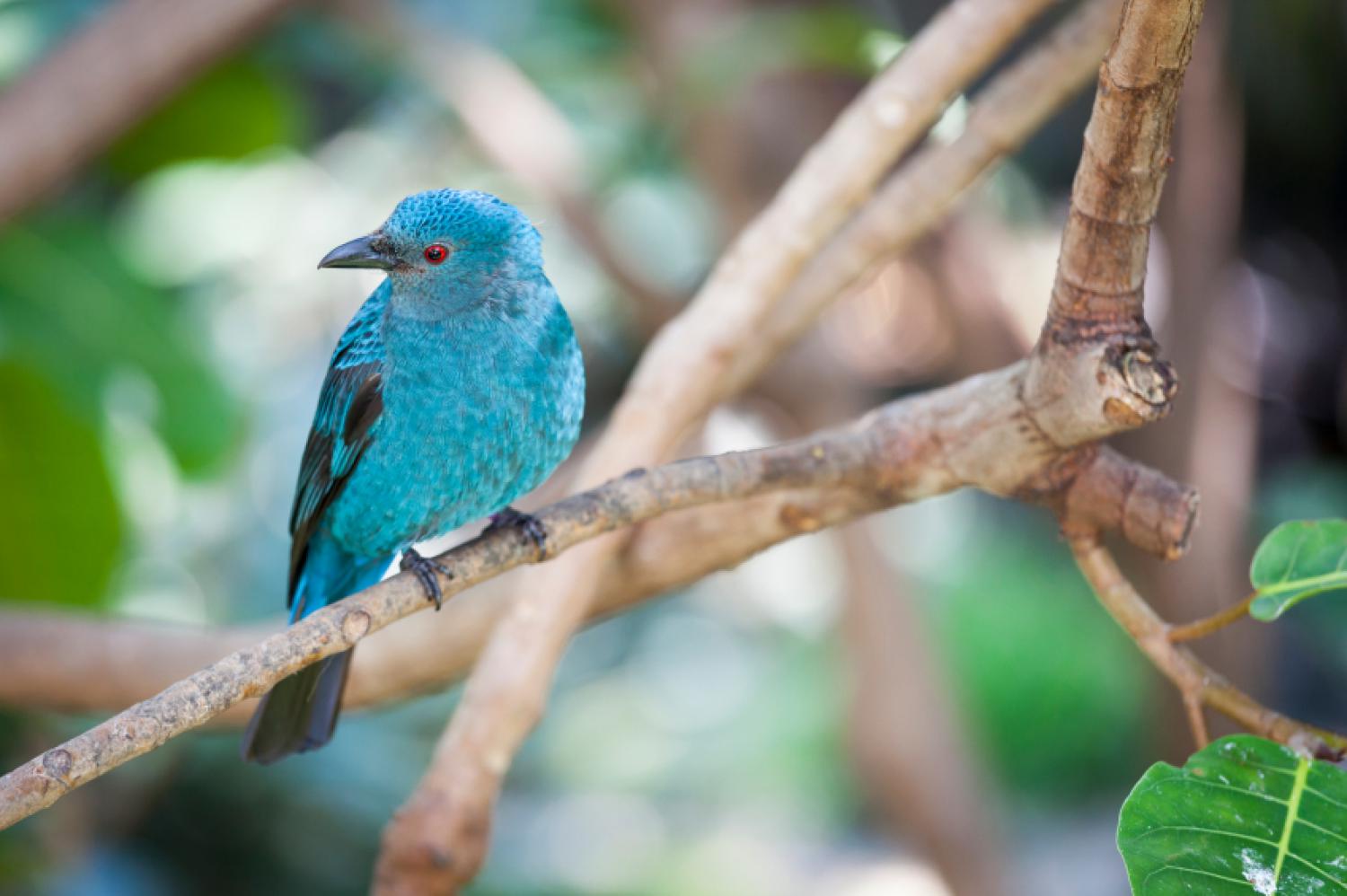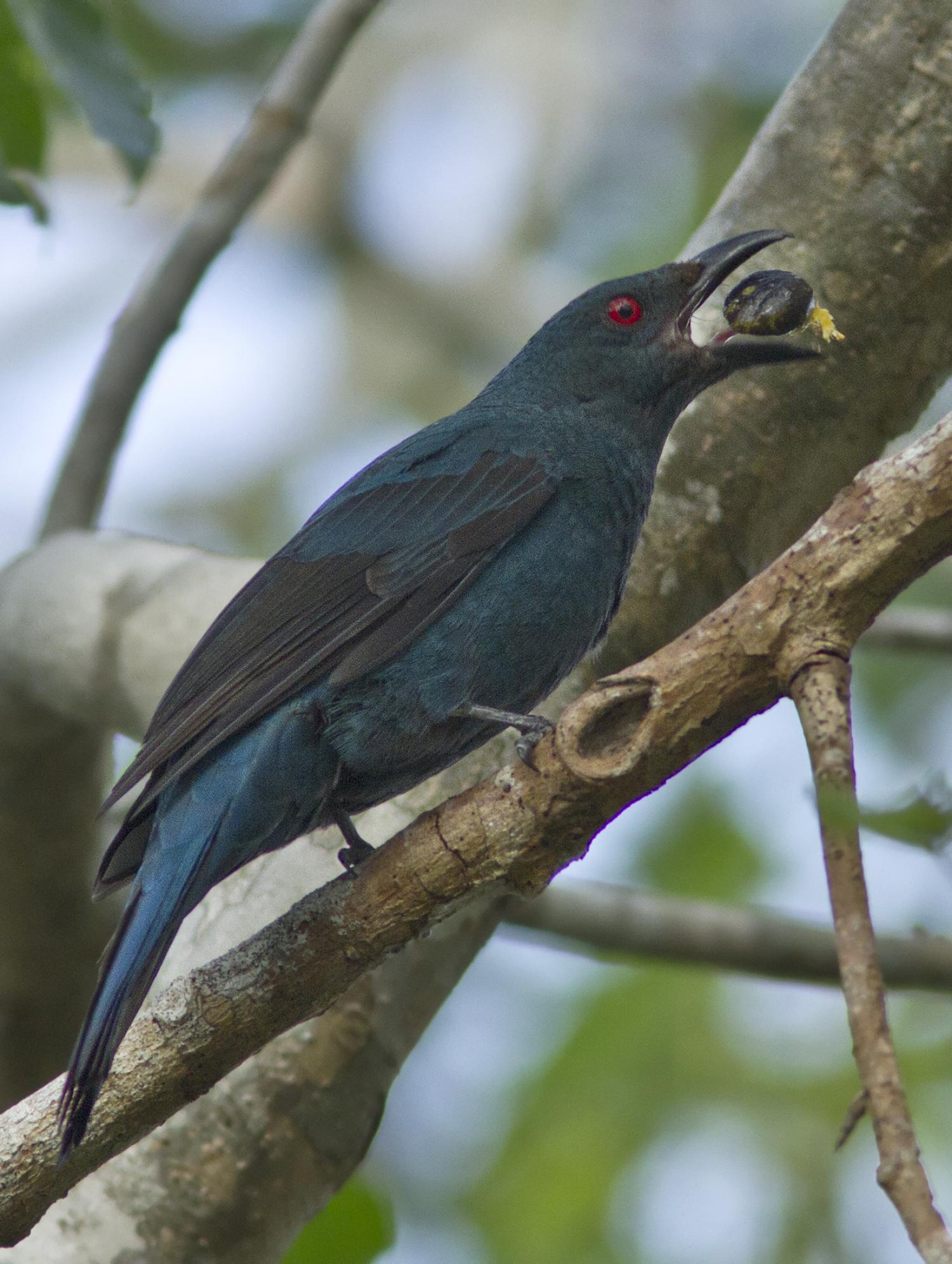Species of Thailand
Asian fairy-bluebird
Irena puella
John Aubrey Clarendon Latham, 1790
In Thai: นกเขียวคราม
The Asian fairy-bluebird (Irena puella) is a medium-sized, arboreal passerine bird.
This fairy-bluebird is found in forests across tropical southern Asia, Indochina, the Greater Sundas and Palawan. Two or three eggs are laid in a small cup nest in a tree. It was described by British ornithologist John Latham in 1790. The only other member of the genus and family is the Philippine fairy-bluebird, I. cyanogastra, which replaces the Asian fairy-bluebird in most of the Philippines. Both species are considered as sacred to the Tagalog people as they are perceived as tigmamanukan omens.
The adult Asian fairy bluebird is about 24 to 27 cm. The male has glossy, iridescent blue upperparts, and black underparts and flight feathers. The female and first year male are entirely dull blue-green.
The Asian fairy bluebird eats fruits, nectar and some insects. Its call is a liquid two note glue-it.
Description
The Asian fairy bluebird measures 24 to 27 cm in length. The iris is crimson and eyelids pinkish; the bill, legs and claws are black, and mouth a flesh- colour. Marked sexual dimorphism is evident. The male is a shining ultramarine-blue with lilac reflections on its upper plumage, lesser wing coverts, and under tail coverts, while the sides of its head and the whole lower plumage are deep black; greater wing-coverts, quills, and tail black, and some of the coverts tipped with blue, and the middle tail-feathers glossed with blue.
The upper plumage, the lesser wing coverts, and the lower tail coverts of the female are brownish blue, with the edges of the feathers brighter. The middle tail feathers and the outer webs of all the others, except the outer pair, like the upper plumage, and remainder of tail dark brown. primaries and secondaries dark brown. The greater wing coverts, primary coverts, and tertiaries dark brown, with a blue tinge on the outer webs. Sides of the head and whole lower plumage blue, very similar to the upper parts. The young resemble the female. The male changes into adult plumage in March, the change taking place without a moult. The feathers of the upper parts first become fringed with bright blue, then the tail coverts change, and finally the lower plumage changes. Young birds with the lower plumage mixed black and dull blue, and the upper plumage like that of the adult are frequently seen.
There are several subspecies, including I. cyanea malayensis from the Malay Peninsula, where the male differs in having the undertail coverts longer, nearly reaching to the tip of the tail.
Distribution and habitat
The Asian fairy bluebird is found in Sri Lanka and the western coast of India from Travancore up to the latitude of Belgaum and Sawantwadi; Sikkim and the lower ranges of the Himalayas to Dibrugarh in Assam; the Khasi Hills; Cachar; Manipur; Bangladesh; Arrakan; Bago and Taninthayi Division in Burma; the Andaman and Nicobar Islands. In southeast Asia it occurs throughout most of Indochina (including Peninsular Malaysia), Sumatra, Borneo, Java, Palawan, and on smaller nearby islands. In the Indian part of its range this species is confined to the evergreen forests of the hills and plains, but elsewhere it is regular in various types of humid and deciduous forests from lowlands up to about 1600 m. The species has been reported to be more frequent in mature rainforests and in rustic cardamom plantations under native shade trees than in coffee plantations.
Behaviour and ecology
This bird is common in most of the tracts it frequents, going about in small parties or in pairs.
Breeding
It breeds from February to April, constructing a shallow cup-shaped nest, sometimes of moss and sometimes of small twigs, in a sapling or small tree. The eggs, which are generally two in number, are greenish white marked with brown, and measure about 1.14 cm by .77 cm.
Feeding
It feeds principally on fruit and is generally found on the larger forest-trees.
Gallery
This article uses material from Wikipedia released under the Creative Commons Attribution-Share-Alike Licence 3.0. Eventual photos shown in this page may or may not be from Wikipedia, please see the license details for photos in photo by-lines.
Category / Seasonal Status
BCST Category: Recorded in an apparently wild state within the last 50 years
BCST Seasonal status: Resident or presumed resident
Scientific classification
- Kingdom
- Animalia
- Phylum
- Chordata
- Class
- Aves
- Order
- Passeriformes
- Family
- Irenidae
- Genus
- Irena
- Species
- Irena puella
Common names
- Thai: นกเขียวคราม
Conservation status

Least Concern (IUCN3.1)

Near Threatened (ONEP)
Photos
Please help us review the bird photos if wrong ones are used. We can be reached via our contact us page.
Range Map

- Ban Bueng District, Chonburi
- Bang Lang National Park
- Chaloem Phrakiat Thai Prachan National Park
- Chiang Dao District, Chiang Mai
- Chiang Dao Wildlife Sanctuary
- Doi Inthanon National Park
- Doi Lang
- Doi Pha Hom Pok National Park
- Doi Phu Kha National Park
- Doi Suthep - Pui National Park
- Fang District, Chiang Mai
- Hala-Bala Wildlife Sanctuary
- Huai Kha Khaeng Wildlife Sanctuary
- Huai Nam Dang National Park
- Huai Yang Waterfall National Park
- Kaeng Khoi District, Saraburi
- Kaeng Krachan District, Phetchaburi
- Kaeng Krachan National Park
- Kaeng Krung National Park
- Khao Ang Rue Nai Wildlife Sanctuary
- Khao Banthat Wildlife Sanctuary
- Khao Laem National Park
- Khao Lak - Lam Ru National Park
- Khao Luang National Park
- Khao Nan National Park
- Khao Phanom Bencha National Park
- Khao Phra - Bang Khram Wildlife Sanctuary
- Khao Phra Thaeo Wildlife Sanctuary
- Khao Sam Roi Yot National Park
- Khao Soi Dao Wildlife Sanctuary
- Khao Sok National Park
- Khao Yai National Park
- Khlong Kaeo Waterfall National Park
- Khlong Lan National Park
- Khlong Nakha Wildlife Sanctuary
- Khlong Phanom National Park
- Khlong Saeng Wildlife Sanctuary
- Khon San District, Chaiyaphum
- Khun Chae National Park
- Khura Buri District, Phang Nga
- Ko Chang National Park
- Ko Lanta National Park
- Ko Phayam
- Kromluang Chumphon Wildlife Sanctuary
- Kui Buri National Park
- Mae Ping National Park
- Mae Wong National Park
- Muak Lek District, Saraburi
- Mueang Chiang Mai District, Chiang Mai
- Mueang Chumphon District, Chumphon
- Mueang Krabi District, Krabi
- Mueang Nakhon Nayok District, Nakhon Nayok
- Mueang Nonthaburi District, Nonthaburi
- Mueang Phang Nga District, Phang Nga
- Mueang Phuket District, Phuket
- Nam Nao National Park
- Namtok Sam Lan National Park
- Op Khan National Park
- Pa Sang District, Lamphun
- Pachee River Wildlife Sanctuary
- Pak Thong Chai District, Nakhon Ratchasima
- Pang Sida National Park
- Pha Daeng National Park
- Phatthana Nikhom District, Lopburi
- Phu Hin Rong Kla National Park
- Phu Khiao Wildlife Sanctuary
- Phu Kradueng National Park
- Phu Suan Sai National Park
- Ramkhamhaeng National Park
- Sai Yok District, Kanchanaburi
- Sai Yok National Park
- Sakaerat Environmental Research Station
- Samut Prakan Province
- San Kala Khiri National Park
- Sangkhla Buri District, Kanchanaburi
- Si Racha District, Chonburi
- Sirinat National Park
- Sri Phang-nga National Park
- Tai Rom Yen National Park
- Taksin Maharat National Park
- Takua Pa District, Phang Nga
- Tarutao National Marine Park
- Tat Mok National Park
- Tha Yang District, Phetchaburi
- Thale Ban National Park
- Than Sadet - Koh Pha-Ngan National Park
- Thap Than District, Uthai Thani
- Thong Pha Phum National Park
- Thung Salaeng Luang National Park
- Thung Yai Naresuan Wildlife Sanctuary
- Ton Nga-Chang Wildlife Sanctuary
- Ton Pariwat Wildlife Sanctuary
- Wang Mai Forest Restoration Project

